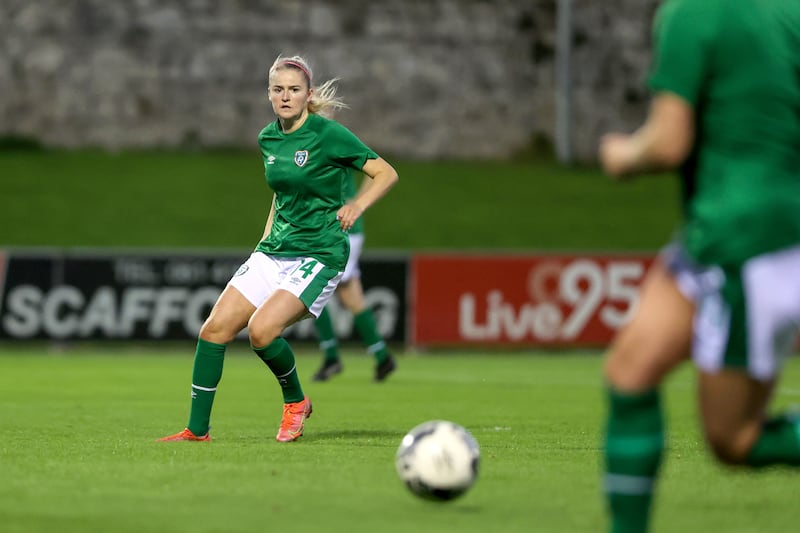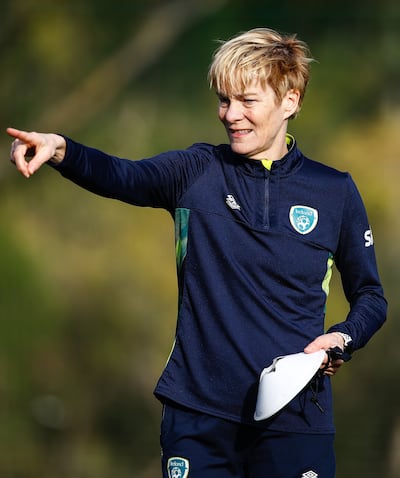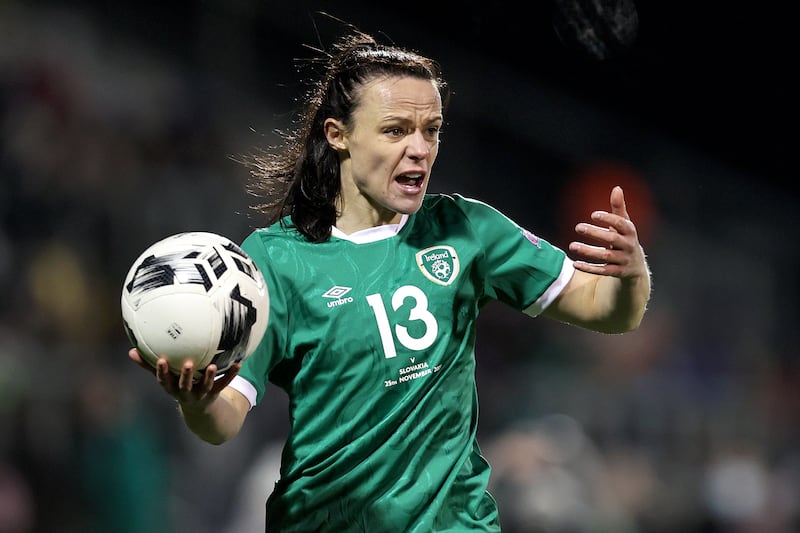It’s Thursday at 4.45pm, and the National Sports Campus in Abbotstown is beginning to wake up.
The iPhone still calls this area Sheep Hill. Once upon a time, Bertie Ahern envisaged these grazing pastures as part of his own legacy. The Bertie Bowl never materialised, but sport lives and breathes upon Cnoc na gCaorach.
The Irish Times reporter arrives early, but The Irish Times videographer is already on-site, filming outside FAI headquarters. Someone inside the granite building saw the cameraman and presumed the worst. A muscle memory from days past.
We are welcomed through the glass doors to interview Erin McLaughlin and Áíne O’Gorman, prospective members of Ireland’s World Cup squad at either ends of their playing careers. The FAI’s CEO Jonathan Hill stalls to say hello, noting the newly painted walls.
READ MORE
“What iconic moment would you like to see plastered on them?”
Ray Houghton lobbing Gianluca Pagliuca in Giants Stadium in 1994.
“Done.”
Vera Pauw zips past and waves, en route to brief the players about the incoming session.
‘I will be the storm’
Thursday is the night that Pauw spends training home-based players. The Republic of Ireland manager flies in from France or the Netherlands, but this week she is staying put for a press conference in the morning, when she will reject sanctions handed down by US Soccer, following an investigation into abuse that threatened to damage her reputation as an elite coach.
“I will stay loud,” said the 60-year-old in response to US Soccer seeking her to admit misconduct during the 2017-18 season as Houston Dash coach. “I will be the storm.”
On this particular evening, Pauw is more of a gentle breeze blowing through the beehive of elite Irish athletes.

McLaughlin arrives, dropping her gear bag and sitting comfortably in a chair. This media lark is no bother to Peamount United’s attacking midfielder, despite journeying from Maynoot, where she is studying to become a primary schoolteacher.
So, you’ve a ready-made career? “Hopefully. Football is Plan A, definitely.”
6.27pm: “Nice weather, for Ireland, yes?” observes goalkeeping coach Jan-Willem van Ede, as coaches, staff and players appear on the artificial pitch. Niamh McDaid from STATSports has her head buried in a laptop as bobbing ponytails begin what, at first glance, appears to be a beep test. Turns out that McDaid is monitoring everyone’s heart rate.
“I think I am the only coach in the world who set the training load on live heart rates, with sports scientists keeping track of the heart rates during our training sessions,” said Pauw, when questions arise about a growing number of ACL tears. “Why are we always ready to play? Why can we always push after the 90 minutes?
“I wish people would ask,:‘Vera, how do you do that?’ and ‘What are the principles?’ because maybe we can learn from it and together we could grow in a safe environment for players.”

Pauw is hoarse, struggling to shake off a winter infection, so Tom Elmes runs the show. This is not unusual as the former carpenter also coaches the Ireland under-16s, and the presence of Dave Connell’s under-19 management allows the boss to crouch behind the goal where Abbie Larkin and McLaughlin, among other World Cup hopefuls, are visibly fatigued after 50 minutes of hard graft. All done with a ball at their feet.
Pauw is a quieter coach than her media persona may have you believe. She delivers succinct messages, developed over decades. She won 89 caps for the Netherlands, then managed her country to the semi-finals of Euro 2009. Before her methods were criticised in Houston, she managed Scotland, Russia, South Africa and coached in Thailand; so, as far as the FAI is concerned, she knows what she is doing.
That’s why boys are so important to play against, it challenges us a bit more
Clearly, the players have also bought into the theory of Football Periodisation championed by another Dutch coach, Raymond Verheijen.
“Explosive movements would be a big thing for Vera,” says McLaughlin, the 20-year-old Donegal native, “being able to make them explosive movements throughout the game. Not just at the start, staying at the high levels, and that’s why boys are so important to play against, it challenges us a bit more.”
6.47pm: Warm-up done, the goalkeepers are away down the far end as the rest switch to the grass. Three orange bibs harass five yellow ones, within a 5m x 10m rectangle. This creates intense competition, with natural talent like Larkin, Aoibheann Clancy and McLaughlin unmissable.
These players can almost touch the World Cup. However, only Áine O’Gorman and Larkin made this month’s 26-strong senior squad with Pauw fast-tracking Manchester United defender Aoife Mannion and US track athlete Marissa Sheva. McLaughlin is unlucky that Sheva has been parachuted into the Marbella camp as the window to make the final squad begins to close.
Culdaff is a small village on the Inishowen peninsula with a beautiful beach and ever-deepening football roots. Rotherham United striker Georgie Kelly hails from Tooban on the other side of Ireland’s most northerly headland. Up home, McLaughlin is known as Erin Fildara – what’s all this?
“Aw God,” she laughs. “In Donegal we have lots of McLaughlins, Dohertys and all the rest. Fildara is like a family nickname on my dad’s side. They are all known as Fildaras. There is no meaning, it is just a nickname. We are all known as Fildaras. Up home I am known as Erin Fildara, but down here it is changed to McLaughlin.”
Mick McLaughlin lent a steady hand to his daughter’s progress until his sudden passing in December 2020.
“I actually played for Culdaff, which was boys only and moved to Sea Rovers for under-14s, just to play girls football. We were getting slashed every weekend, 12-0 and the like. The manager needed some support, so my dad, who coached the reserves senior team, stepped in and helped the girls. We drove on after that. He was a good coach, he pushed us harder than anyone else did.”

Vera Pauw is forever pressing the importance of playing with teenage boys, you clearly agree?
“I stayed in the boys league until under-16. It really stands to you.”
It gets fairly physical? “It was what I was used to. When I started playing football at five or six it was mixed. As you get older you see the girls drop off, so there was only a couple of us. I rather play with the boys than the girls.”
Because of the standard? “It was my local team. Culdaff was the team I wanted to play for.”
7pm: The group breaks into five versus five games, with goals added and the ‘keepers playing out to feet. Mistakes are exacerbated in the tight confines. Shelbourne’s 16-year-old goalie Katie Keane looks the part.
All going well, these players will end up being scouted by an WSL club. “Yeah, that’s my ambition,” says McLaughlin, “go pro and play in England but at the minute I’ll get the degree. Two years left.”
How do you break into the World Cup squad? “I thought I was a million miles away until November. I played in the non-capped match against Morocco and did well. After being in the squad, I realised I can make it. Having Vera every week, I am adding to my load, training more intensely and with boys.”
Having ducked and dived rush hour traffic, Áine O’Gorman lands into the room. “There was a fire on the motorway,” she drily remarks.

Now 33, O’Gorman has seen it all, twice over. She negotiated with John Delaney, scored an own goal in Ukraine that killed the Euros dream, played professional, played amateur and everything else in between. On the night of nights in Hampden Park, she reappeared in her old top right attacking role.
“I remember sitting in the changing room thinking: it’s another game of football, stick to your task, stay in the moment. Like, it could have been my last game playing for Ireland, or we’d be going to the World Cup.
That’s my ambition, go pro and play in England, but at the minute I’ll get the degree. Two years left
“It was a big pressure situation but as soon as Courtney saved the peno, we knew it was meant to be. The hair still stands on the back of your neck when I see Amber Barrett’s goal going in and the celebrations after. But when you are an elite athlete, you cannot stay in the moment too long, you have to keep looking at what is next.
“When you retire, you can reflect on how magic it all was.”
7.20pm: Elms calls for “one v one duels, let’s get after the ball.” This is gritty stuff. Fatigued bodies begin to sort the women from the girls.
O’Gorman wears many hats. She teaches a nutrition module to early school leavers seeking another run at further education, she’s a professional coach in the making, a defender, a winger, but most of all she is a mother.
“The plan was to start my Uefa A Licence this year but with World Cup prep and Shamrock Rovers I won’t be able to do it, so hopefully after the World Cup I will be able to pursue that.”
Not one of the women’s League of Ireland clubs is managed by a woman, so it’s a future gig waiting to happen? “Yeah, I’d like to think so. I’ve done my Uefa B, Uefa B elite. I think it is really important that we have female coaches in the country and for me to give back to the game.
“I am very passionate about the game here in Ireland. That’s why having home-based sessions once a week is something we have always been crying out for, especially for the young players developing and coming through, so someday they can go over to England or break into the Irish team.”
Last July, O’Gorman and her wife Rachel had a baby boy. James was pitch side for the victory over Finland in October.
“That was a lovely moment. It feels like ages ago now. That was his first game.”
In reality, you have three full-time jobs at the moment?
“Thriving in the chaos.”
How do you manage?
“I love being busy, and I have good support from my partner and my family around me, that makes it all happen. And my job as well. The main focus this year is the World Cup and preparing for that, and hopefully living the dream.”
7.29pm: The session ends just as Sport Ireland’s anti-doping officers arrive for unannounced testing. Two names are selected randomly to supply urine samples. “Drink plenty of water, girls,” says Dr Siobhan Forman.
The players get dinner packs from Gourmet Food Parlour, which they can take for the drive home or eat inside.
It’s 7.45pm, and Sheep Hill is transformed. Bertie Ahern never got to build his bowl, but next door to the FAI, the rugby dome hosts what is probably the Ireland under-20 squad. The Gaelic pitches illuminate the night sky. The aquatic centre car park is crammed. Something special could be happening here.















